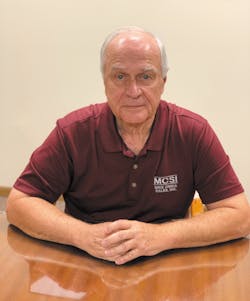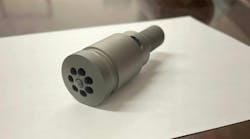Mike Cindia has seen a lot of changes in the plastics industry since he started in the industry in 1971. The owner of Mike Cindia Sales Inc., Cindia, began working for sales-rep agencies in 1978. In this interview with Bruce Adams, Plastics Machinery Magazine senior staff reporter, he reflects on some of the challenges he’s encountered.
Where did you go to college? What were your first jobs in the plastics industry?
Cindia: I attended Tri-State University, which is now known as Trine University, in Angola, Ind. I got a Bachelor of Science degree in mechanical engineering in 1971. My first job in 1971 was working at the Hoover vacuum cleaner company in [North] Canton, Ohio, where I was hired to be an injection molding process engineer. I started designing injection molds, then I worked with our mold making vendors to get the molds built. I also had to get the molds to run on cycle and make good parts. At that time, Hoover had about 250 to 300 IMMs.
After four years, I left Hoover and worked for Geauga Plastics, a blow molding plant in Canton, Ohio, in facilities engineering. From there, I went to the Abbott Labs plant in Ashland, Ohio, as their injection and extrusion process engineer. Then I was plant manager of Majestic Molding in Elyria, Ohio.
Discuss the events that led you to start your own company.
Cindia: I left Majestic Molding and started working for Richard Boyd and Associates, a sales rep agency in Pittsburgh that no longer exists. Everything was going well until the NPE when Cincinnati Milacron introduced its one-stop shop. They wanted you to buy their molding machine and all their auxiliaries. This caused the Van Dorn company to go into a tizzy because they were not offering that. Van Dorn went to my boss and said that if he would let me go work with their Ohio rep, he would get more Van Dorn territory to sell in Pennsylvania. He agreed and let me go to work for the Ohio agency, but I soon found out they were not being honest with me, so I left and started my own agency.
After starting your company, when did you realize that you could make it your career?
Cindia: I was working for other rep agencies from 1978 to 1983, and I liked it. When I started my own rep agency, several companies came to me to sell their equipment. First came AEC, which took its line away from the Ohio agency they worked with and signed me. Other companies that I had competed against also approached me. Some of these were Tier 1 suppliers. This gave me great confidence and the realization that I had found my career.
In your early years in business or in life, who was your mentor?
Cindia: During my “real jobs” career, I bought most of the plastics equipment my companies needed from Bill Burton, a sales rep. He sold in Ohio and was like a partner with Richard Boyd, who sold in Pennsylvania. One day over lunch, Bill told me he planned to retire, and he thought I would make a great salesman. He said I would make good money and play a lot of golf. He lied about the golf! But he spent a lot of time with me, introduced me to his customers and taught me about the product lines. He was nearing the end of his career and spent a year working with me and developing my skills. He was great!
What major challenges did you encounter as you grew your business?
Cindia: Having the right people working for you, and the number of people needed to cover the territory. Our agency now covers western Pennsylvania, all of Ohio, Indiana, Michigan, Kentucky and West Virginia. I’ve been looking for a rep for three years to cover a territory. I’ve had two accept the job. One guy lasted a week and moved back to California due to bad weather here. Another guy accepted, but his boss offered him more money, so he stayed there. Reps have to be personable, know their own product line and know their competitors’ product lines. Most reps I meet don’t have a wide depth or breadth of product knowledge.
It’s hard to find people who want to work for commission only. Some rep agencies give more job security, such as a salary and car. With ours, we don’t get paid until our principal gets paid. It is not uncommon to get a big check one month, then little to nothing the next two or three months. It is a balancing act of putting away money when you get it, so you have it when you don’t sell something.
What is the greatest challenge you faced in your business career?
Cindia: A molding machine manufacturer that we represented enticed three of my salesmen to leave me and start up their individual agencies. One of them I felt very close to. We haven’t talked in many years. Filling those three spots was a big challenge.
What are some of the most important milestones that your company reached through the years?
Cindia: Surviving my first and second year in business. Growing the business – we sold more equipment every year in the same territory for five years. Expanding the territory five times, from one person in northeast Ohio to six people in six states. Staffing up to effectively cover the growing territory. Trying to be the best rep each year for each of our products.
To what do you attribute your company’s success?
Cindia: Honesty. You can never regain your reputation once it’s lost. We offer economical solutions to our customers. We never oversell what is needed to solve the problem. We walk away if we can’t solve the problem, but we’ll try to help the customer find a vendor that can help them. We approach the customer with a mind toward engineering. We ask, “What is your problem? What issues are you having?” We try to give the customer two or three alternatives and explain all the ups and downs.
Do you offer value-added engineering services to processors? Does your company do any machine set-up?
Cindia: Yes. I am an engineer. There are hundreds of systems in our territory that I designed. When we go to a plant, we evaluate their systems, share different potential solutions and present pros and cons of each solution. We provide sketches, drawings and cut sheets of the items needed. We bring years of experience to our customers. I’ve seen hundreds of systems, and I know what will work and why. We have several contractors we work with that will install equipment, run control wiring, do machine start-up and train the customer. We start a project at the beginning and see it through to the end. Our customers can go about their business and not worry about all these things.
Your website prominently mentions Saigh Solutions LLC. What is the nature of that partnership?
Cindia: Dan Saigh and I got together four or five years ago. He was a one-man agency trying to cover a large territory by himself. His efforts to add people were unsuccessful. He was getting burned out and didn’t have anybody to cover for him if he took time off. We formed a partnership that was good for both of us. We realigned our territories when he came on board and made a territory for him. He sells my equipment in his territory and we sell his equipment in the territories we cover. He runs his own business, but he is an extension of my company. Most importantly, Dan will eventually take over when I retire.
How do you decide which companies you want to rep for?
Cindia: I don’t look for companies to rep, they seek me out. We have a lot of companies that we represent now. We rep more than 20 companies, including Una-Dyn, Thermal Care, Yizumi HPM, Maguire, Polymer Systems and Dyna Con. They must have a uniqueness that may open a door for us in another market, or they have to be leaders or trendsetters in the industry. They must stand behind their products 150 percent. We are not looking for another me-too company to sell.
The number of rep firms is declining. What does that mean for the future of the rep business? To processors? To companies that sell through reps?
Cindia: Reps will be around for a long time because they are the least expensive way for a manufacturer to get their products to customers. The direct sales model is very expensive to the manufacturer. If rep agencies are not in demand by the customer, they go out of business. When business gets tight, you see some rep agencies give up, or stop selling plastics equipment to sell other things. During my 35-plus years, I have seen my competitors leave plastics to sell cars and shoes. When customers start buying plastics equipment again, they come back to the industry. Not all rep firms are equal. On the low end, you have the order-takers. The ones that disappear in lean times are the order-takers because they add no value. The good reps that know their products and their competitors’ products will win out.
Are some companies putting independent reps on salaries/retainers or hiring their own full-time salespeople due to the declining number of rep firms?
Cindia: I don’t see that happening a lot. In the past, some companies have tried to go with company payroll salespeople instead of reps and failed. But if a company is a second- or third-tier supplier, I can understand them doing this if they think they have good salesmen.
How has the function of the independent sales rep evolved over the years, and what has that meant to your business?
Cindia: Technology has made the job easier and made us more efficient. I remember when I had a trunk full of literature. That was my sales tool. After that, I used paper notebooks with flip charts. Now I have an iPad with photographs of installations and systems we have installed. I can take calls on the road and do a quote from my car. I can email quotes and information from my iPad. Those are important tools because you’ve got to strike when the fire is hot. Other projects may come up that become more important, and what they were asking about is no longer on their radar.
Do you feel like you work for the companies you represent or the processors that you sell to?
Cindia: We work for the customer. If the customer doesn’t buy, we never get paid. I’m their chief engineer. But I have responsibilities to the manufacturer. We have to walk a fine line during the transaction. We must be great mediators when there are issues between the manufacturer and customer. We try to get both parties to meet somewhere in or near the middle. When there is a problem, we have to figure out who is at fault, the manufacturer or the customer. One time I made a mistake in the design, and I paid the company about $3,000 to make it right. If everyone is willing to honestly accept their contribution to the problem, everyone wins and we all continue to work together.
Do you sell more turnkey cells now than in the past? Are robots purchased with most or many sales?
Cindia: Yes, we sell more turnkey cells. A lot of our customers have downsized who they will do business with. They expect the rep to handle everything. Instead of selling just a molding machine or extruder, I might also be selling other auxiliary equipment. I become their vendor. I negotiate the deal and write three or four purchase orders to my vendors.
When I first started selling IMMs back in the 1980s, one of 10 machines might have a sprue picker. Now 90 percent of IMMs have either a picker or a three-axis servo robot. When you can’t get people to run the machine, you need automation.
Are you seeing a slowdown in sales now compared to one or two years ago?
Cindia: Sales have been flat the last three or four years. I believe there are two factors affecting our sales. Even though business is good for our customers, they still have unused production capacity, so they don’t need a new machine or extruder. Customers won’t buy new equipment until they absolutely need something. Even if their sales picked up, they will be reluctant to buy because they cannot find workers to run those machines.
What is your impression of Industry 4.0 and its future in the plastics industry?
Cindia: Industry 4.0 is still in its infancy. If you ask suppliers what they are doing to meet Industry 4.0, they all have different answers. Industry 4.0 was the buzzword at the last NPE. When you looked to see what they had, it was different from other companies who said they had Industry 4.0.
What do you see as the next phase of manufacturing development or machine automation?
Cindia: When manufacturing can’t get people to employ and machines are sitting idle for lack of an operator, automation happens. That’s why most new IMM sales come with robots. The next step would be adding vision systems to inspect each shot. Secondary tooling to do additional value-added steps — box and seal cartons, palletize and ship — also are important. There aren’t many jobs where the length of the run would pay the costs for full automation, but they can start by adding the pieces that are missing on each press as their budgets allow. You will see more lights-out type applications in the future. 3-D printing quality and speeds have improved. Maybe we won’t have as many IMMs for short-run items.
Where do you see the plastics manufacturing industry 10 or 20 years from now?
Cindia: From a chair on the beach of a tropical island! I still marvel at how far 3-D printing has come and wonder what it will be able to do in the future.
Do you have any hobbies? What are they?
Cindia: I have three hobbies. My passion is as a self-defense handgun instructor. I have my instructor’s card from the National Rifle Association and the United States Concealed Carry Association. It all started when my daughter was stopped by a young man in a parking lot at the hospital where she works. She got away from him and wasn’t hurt, but it made my three daughters want to get their concealed carry permits. I was not impressed with the training they received when they applied for their CCW permit. I felt the need to make sure my daughters and others get a better idea of self-defense and their situational awareness. I teach the skills they need to defend themselves instead of just target shooting.
I play golf two or three times a month. I used to love going to the racetrack with my car to take high-speed driving classes. I haven’t done that in several years.
How would you like to be remembered?
Cindia: That I was always ready to help, even when I couldn’t sell them something. If I was allowed out on their shop floor, I would show customers how they could get better results with some small changes. Plus, I was fun to be around!
Do you have any memorable sales experiences?
Cindia: I had a competitor who sold Milacron machines against me. He decided he could make more money by being a molder than a sales rep. He wanted to get into injection molding, but he already had his IMM supplier. He called me and said he trusts me, and he wanted to buy my auxiliary equipment. That was the nicest compliment I ever received.






